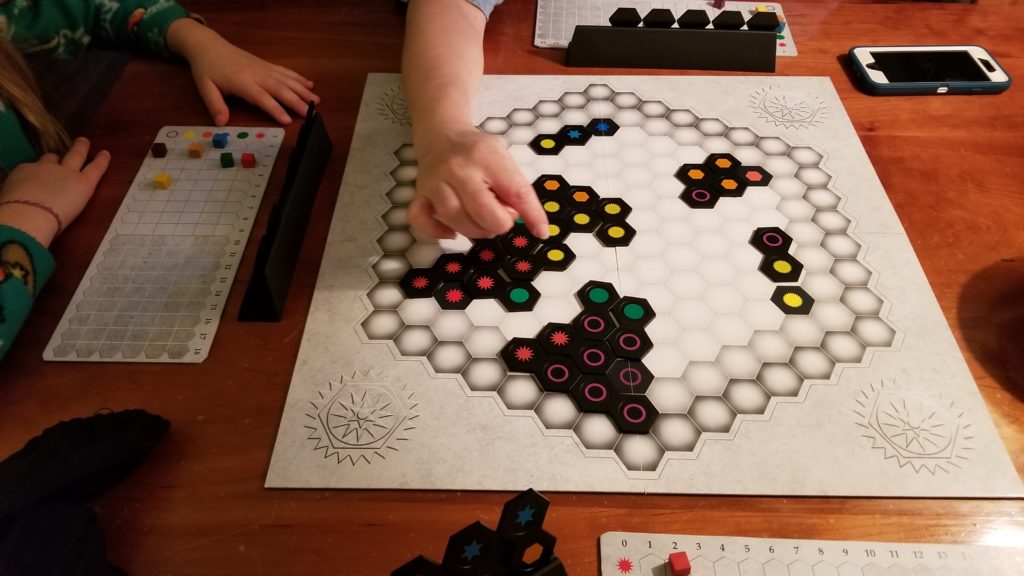
Ingenious is a great game and can be played by kids and grown-ups alike.
Players have a “hand” of six funky two-hex tiles (which look something like futuristic domino tiles) with varied combinations of six coloured symbols on them, that you lay onto the board so that those symbols connect with like symbols already in play. The more like symbols radiate from the tile you just played, the higher your score for that symbol/colour.
This has a twist on the scoring system, however, which I’d never seen before, but which I understand that designer Reiner Knizia has done in other games of his: Players move up coloured markers on their scoring cards, but it’s the lowest marker points that indicates your score. You could be slam-dunking your points on five of six colours, but it won’t matter if just one is left way behind, because that is your current number of points.
This approach makes for a unique play experience where you want to ensure that all of your colours are looked after and are moving up so you don’t get caught too far behind anyone else’s lowest point marker.
A great game that deserves its tabletop game awards.
The second game we played was a new one for us: Fast Flip Pizza

This is a quick card game that’s made for younger players, but my wife and I had fun, as well.
All the rounded triangle shaped cards are shuffled and placed face-down so all players can see them (and you’ll need to see them in detail throughout the game, so get close).
As each (let’s call it “active”) card is flipped, you must call out the correct answer for what pairs the revealed card with the back of the next card (let’s call it the “deck” card, because it’s still in the deck). I’d never seen this mechanic used before, and it sounded a bit odd at first, but stick with me, here…
This was a pizza-themed game–there are others in this line of games–so the faces of the cards were pizza slices with cartoony toppings on them, such as green pepper, olives, mushrooms, and pepperoni. The active card would be flipped to reveal its unique arrangement of pizza toppings, and the players have to look at that card in the context of what was on the back of the deck card, which may be a single topping or a number from 1-5.
If the back of the deck card said 1, for instance, such as in the photo above, you’d want to call out which topping there was only one of on the active card (and there’s only one right answer). Whereas if the back of the deck card was, say, a single olive, you’d need to count up the olives on the active card and call out the correct number.
The first person to call out the correct answer wins that card–calling out a wrong answer eliminates you from contention to win that card–and then the next card from the deck is flipped over and the process repeats itself (with a different combination of pizza toppings and number or specific topping on the deck card) until there are no more deck cards remaining.
It’s really quick to grasp and very fast to play. We got two games in within probably five minutes, and there were smiles all around the whole time. It’s not something I’d go to a friend’s place just to play, but I’d happily play one or two games of it–making this one I guess an “interstitial” game?–in between heavier hitters.